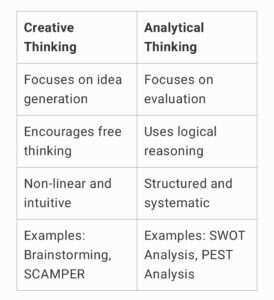Entrepreneurs constantly seek innovative ideas to create, improve, and scale businesses. To achieve this, they use various creative thinking exercises that encourage out-of-the-box solutions. However, not all exercises contribute effectively to idea generation. Some methods may seem productive but fail to stimulate genuine creativity.
However, not all exercises contribute effectively to idea generation. Some methods may seem productive but fail to stimulate genuine creativity.
In this article, we will explore well-known creative thinking exercises used by entrepreneurs, identify which one does not belong to this category, and discuss why it may not be effective for idea generation.
Understanding Creative Thinking in Entrepreneurship
Creative thinking in entrepreneurship is the ability to approach problems and opportunities from a fresh perspective, leading to unique solutions. It involves:
- Divergent Thinking: Generating multiple ideas without immediate judgment.
- Convergent Thinking: Narrowing down ideas to select the most feasible ones.
- Lateral Thinking: Looking at problems from unconventional angles.
To facilitate this, entrepreneurs use various exercises that enhance creativity, challenge assumptions, and break mental blocks.
Common Creative Thinking Exercises Entrepreneurs Use
1. Brainstorming
One of the most popular creative thinking exercises, brainstorming involves a group of people generating as many ideas as possible without criticism. The focus is on quantity over quality, allowing creative flow without judgment.
Why It’s Effective
- Encourages free thinking.
- Allows team collaboration.
- Generates multiple ideas rapidly.
2. Mind Mapping
Mind mapping is a visual exercise where ideas are connected in a diagram to explore relationships between concepts. It helps entrepreneurs structure their thoughts and identify new possibilities.
Why It’s Effective
- Helps organize and expand ideas.
- Stimulates connections between concepts.
- Encourages non-linear thinking.
3. SCAMPER Technique
SCAMPER stands for Substitute, Combine, Adapt, Modify, Put to another use, Eliminate, Reverse. This structured approach helps entrepreneurs refine or reinvent existing ideas.
Why It’s Effective
- Offers a systematic way to innovate.
- Encourages new perspectives on old ideas.
- Provides a framework for problem-solving.
4. Role-Storming
Role-storming is an exercise where participants take on different roles or perspectives to think of ideas. This method helps remove personal biases and explore creative solutions.
Why It’s Effective
- Encourages empathy-driven innovation.
- Helps break habitual thinking patterns.
- Promotes diverse viewpoints.
5. Reverse Thinking
Instead of looking for ways to solve a problem, reverse thinking involves brainstorming ways to worsen a situation. By flipping the problem, entrepreneurs can uncover unconventional solutions.
Why It’s Effective
- Encourages unconventional ideas.
- Breaks fixed thinking patterns.
- Often leads to surprising insights.
6. Forced Connections
This exercise involves taking two unrelated concepts and trying to create connections between them to develop new ideas. For example, combining “smartphones” and “healthcare” may lead to a telemedicine app.
Why It’s Effective
- Stimulates innovation by merging different industries.
- Encourages thinking beyond obvious solutions.
- Helps find unexpected business opportunities.
Which of the Following Is Not a Creative Thinking Exercise?
While all the exercises above encourage creativity, there are certain activities that do not effectively contribute to idea generation.
Traditional SWOT Analysis
A SWOT analysis (Strengths, Weaknesses, Opportunities, and Threats) is a strategic planning tool used to evaluate a business or idea.
While useful for decision-making and risk assessment, it is not a creative thinking exercise because it focuses on analyzing existing factors rather than generating new ideas.
Why SWOT Analysis Is Not a Creative Thinking Exercise:
- Evaluates Instead of Creates: Unlike brainstorming or mind mapping, SWOT does not encourage free-flowing ideas but rather assesses what already exists.
- Structured and Analytical: It follows a rigid structure, which limits divergent thinking.
- Focuses on Strengths and Weaknesses: While important, this approach is more about business strategy than ideation.
The Difference Between Analytical and Creative Thinking
Understanding the distinction between analytical and creative thinking is crucial: Since SWOT analysis is analytical rather than creative, it does not belong in the category of exercises entrepreneurs use to generate new ideas. Instead, it is used to assess ideas after they are generated.
Since SWOT analysis is analytical rather than creative, it does not belong in the category of exercises entrepreneurs use to generate new ideas. Instead, it is used to assess ideas after they are generated.
The Importance of Choosing the Right Exercise
Entrepreneurs must choose exercises that align with their goal whether it’s idea generation, refinement, or execution.
Using SWOT analysis during the ideation phase may restrict creative potential, whereas using brainstorming or mind mapping can help generate more innovative solutions.
Conclusion
While many exercises foster creativity, not all are designed for idea generation. Traditional SWOT analysis is more about evaluating existing ideas rather than creating new ones, making it not a creative thinking exercise.
Entrepreneurs looking to generate fresh business ideas should focus on methods like brainstorming, mind mapping, SCAMPER, and forced connections to unlock their creative potential.
By understanding the distinction between creative and analytical thinking, entrepreneurs can use the right tools at the right time, ensuring both innovation and strategic decision-making in their ventures.
